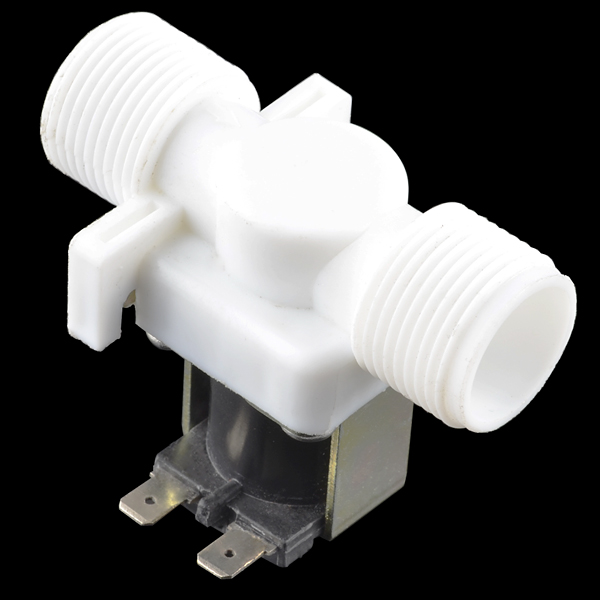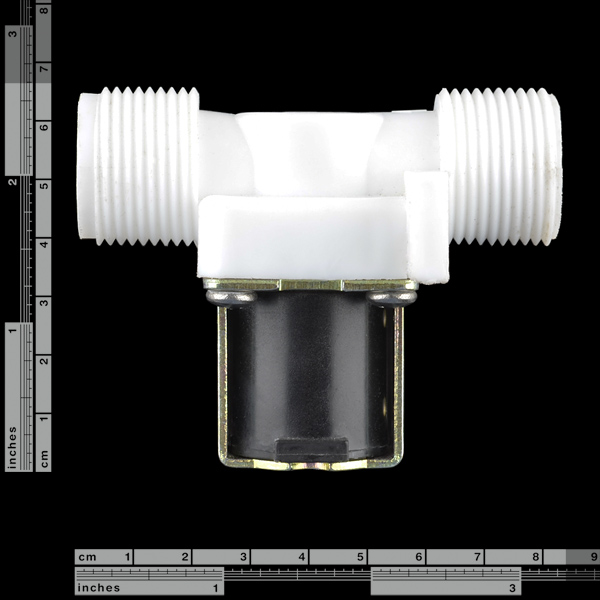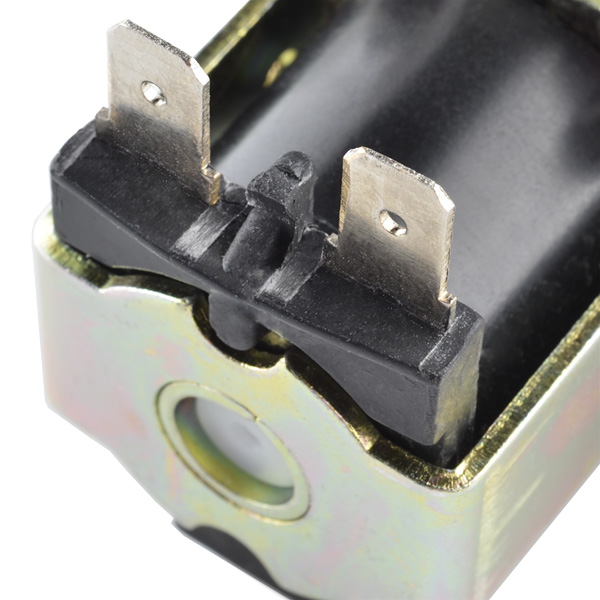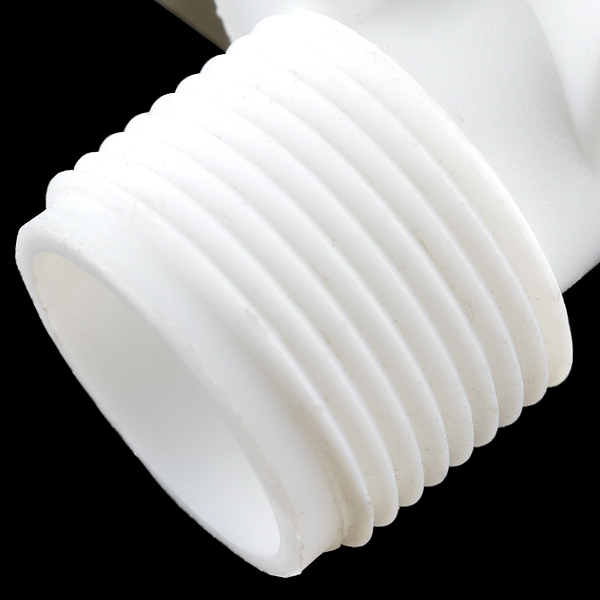Have you ever wanted to control the flow of a liquid using your computer or microcontroller, but didn't know how? Well, here's how: The 12V solenoid controlled fluid valve. Simply connect a fluid source to the 3/4" threaded inlet and it will interrupt the flow until 12V is applied to the fast-on connectors on the solenoid.
Note: This is not a gravity-feed solenoid. This means that you will need enough water pressure to fully open the valve. Check the datasheet below for exact details. It operates at a minimum of around 3 PSI, allowing around 3 L/min of flow. Although the datasheet shows the valve working at 220 VAC, it's actually 12 VDC. Our 350 GPH pump does not have enough pressure for this valve. A garden hose or other pressurized system should work just fine.
- Datasheet (AQT15SP)
12V Solenoid Valve - 3/4" Product Help and Resources
Resources & Going Further
To control the solenoid from a microcontroller, you'll need to add a flyback diode and a MOSFET/Relay. For more information, check out the application circuit in our diodes tutorial. The solenoid will simply be added as a load on the MOSFET or relay of your choice.
Core Skill: Robotics
This skill concerns mechanical and robotics knowledge. You may need to know how mechanical parts interact, how motors work, or how to use motor drivers and controllers.
Skill Level: Noob - You will be required to put together a robotics kit. Necessary parts are included and steps will be easy to follow. You also might encounter basic robotics components like bearings, mounts, or other hardware and need a general idea of how it goes together.
See all skill levels
Core Skill: DIY
Whether it's for assembling a kit, hacking an enclosure, or creating your own parts; the DIY skill is all about knowing how to use tools and the techniques associated with them.
Skill Level: Noob - Basic assembly is required. You may need to provide your own basic tools like a screwdriver, hammer or scissors. Power tools or custom parts are not required. Instructions will be included and easy to follow. Sewing may be required, but only with included patterns.
See all skill levels
Core Skill: Electrical Prototyping
If it requires power, you need to know how much, what all the pins do, and how to hook it up. You may need to reference datasheets, schematics, and know the ins and outs of electronics.
Skill Level: Noob - You don't need to reference a datasheet, but you will need to know basic power requirements.
See all skill levels
Comments
Looking for answers to technical questions?
We welcome your comments and suggestions below. However, if you are looking for solutions to technical questions please see our Technical Assistance page.
Customer Reviews
3.9 out of 5
Based on 7 ratings:
2 of 2 found this helpful:
No problems; seems fairly durable.
It works well for it's purpose; quick reaction times.
If you use this in a home garden setup, I recommend getting PVC adaptors to take the threads from pipe style to garden hose style.
I would recommend using blade connectors instead of soldering to the connection tabs; I had a hard time getting the solder to stick properly.
1 of 1 found this helpful:
Inexpensive 12 volt electrically controlled water valve
I originally purchased this item for my hydroponics garden. Tests show the valve only works while under water pressure, kind of a safety feature. Then I though about a fountain display I wanted to build. I just purchased 8, 1/4" direct stream water nozzles. Besides interfacing this valve to standard pipe is the creation or purchase of a 12 DC, 8 channel control box.
There is many possibilities and uses for this product. Still wish for a low pressure valve for my hydroponics.
1 of 1 found this helpful:
Works well
Unlike other sellers this is advertised correctly; customer service quickly responded to a question - this is a normally closed valve. Was able to fit connectors on to run power leads; connection with garden hose water source pretty solid. Overall this valve works quite well.
1 of 1 found this helpful:
Not as good as expected...
I ran this off a garden hose with ample pressure to the garden irrigation I've set up, off of a 12v 3.3amp PSU.
For the first 30 seconds or so after switching the valve on, the pressure is about 80% of what it was before the solenoid was installed. After those thirty seconds, the pressure drops dramatically to about 30%, and all the sprinklers and sprayers just start spurting little puddles. If the solenoid is switched off and then on again, the pressure is good for another 30 seconds. I'm assuming it's because my hose is probably running at around 0.3 Mpa, and my flow rate is supposed to be around 22 lpm. This solenoid's data sheet (well, the 1/2" version listed anyways) says it needs 0.8 Mpa to reach 35 lpm. Unfortunately 0.8 Mpa would probably explode most of the 1/4" irrigation plugs.
Also, the solenoid was hot to touch after my initial tests (about 10 minutes of use).
If flow rate/pressure stability/lengthy use is your goal, this doesn't cut it. For quick fun hobby applications, it should work great.
Hmmm, this isn't behavior we've seen with this unit before. It sounds like you may have received a faulty unit. We're sending you out a new one, and hopefully that will fix the problems you're seeing.
Leaky = Useless
The plastic threads are soft and deform extremely easily. This makes it almost impossible to get a tight enough fit to stop it from leaking, which means it's useless.
It works but requires a gender changer to be useful
That has been working well to control the drip system in my garden. But why did they make it male to male? You'll have to get a gender changer and apply a lot of plumbers tap to make it not leak.
Just what I needed
This is just what I needed thanks for all the spec on it that helped a lot.





If anyone is interested I have created a cover for the solenoid. I can put it on thingiverse if requested.
Is the material translucent (polypropylene) or opaque (nylon plastic). From the image it looks like the later. Problem I've had with PP is that algae starts growing in it when exposed to sunlight.
I am not absolutely sure since it isn't listed in the datasheet, but I am pretty confident that you are correct and that it is made of polypropylene. Also, good tip!
If I wanted to run a self water system off my Arduino that is solar charged using a Li Po battery that gives out 3.7V. How would I get that 3.7V supply to trigger the solenoid to open?
Can I use this valve to control the flow of co2 gas?
-------------------- Tech Support Tips/Troubleshooting/Common Issues --------------------
Example
Here's an example of controlling a solenoid valve with Arduino [ http://www.bc-robotics.com/tutorials/controlling-a-solenoid-valve-with-arduino/ ]. You will need a transistor and a flyback diode to protect your microcontroller.
Partially Open?
Haven’t test this but I doubt you can control the valve to be partially open. A solenoid is usually on or off. If customers are looking to adjust the flow rate from a tube, they would need something like a flow control valve.
I would like to trap some air in a box. I will get the air in with a Vaccum pump and my idea is to trap the air with two solenoid valve. One where the aire comes in and the other to take the air away. Do you know if I could do that with this valve? Thank you.
I don't get why datasheet and also the official website of the manufacturer of this product states it's 220VAC, but SparkFun says it's 12VDC. I've sold my self several of these so it must be 12VDC but....can someone clarify this?. How can the manufacturer got it wrong on their website and datasheet? Thanks.
Has anyone noticed that the valve leaks very slowly even when it is closed? I set up a few tubes with the solenoid in the middle to test for leaks, with the water supply a few feet above the solenoid so gravity provides it with enough pressure, and noticed that over a period of a few hours I would get a few drops of water coming through the solenoid valve despite it being in the closed position. A few drops doesn't matter for my purposes, but it's worth noting if this thing isn't water tight when closed.
The datasheet solenoid specifications don't match this part.
Here's are the real measurements:
The coil DC resistance is approximately 39 ohms.
The operating current is about 300 mA at 12VDC, and it will take it continuously without overheating.
The connector TPI on both sides of the device are the same, at about 13.5 (GHT is 11.5 TPI).
The pipe connectors are not GHT (garden hose thread); they are standard 3/4" PVC type pipe thread that you can find at home supply and plumbing stores. An adapter to convert to GHT is about $1.50 at Home Depot.
This is a pilot assisted diaphragm valve, which means that it has a distinct input and output (it's not a bidirectional valve). There's a screen filter on the input side. The tabs that jut out are for mounting the solenoid; they are on the input side and have metric threaded metal nuts embedded in them.
The threads are not the USA standard National Pipe Thread Taper (NPT) but rather British Standard Pipe Parallel (BSPP). Both NPT and BSPP have the same pitch, .071in or 1.814mm, but NPT has tapered threads while the BSPP has parallel, or straight, threads. Depending on the fitting you may or may not be able to cram an NPT onto the BSPP valve threads, but you will not get a reliable seal. The NPT threads rely on the taper to seal while the BSPP relies on an end gasket to seal (like on a garden hose fitting). BSPP threads are very uncommon in the USA. McMaster-Carr sells a BSPP-to-NPT adapter fitting for about twice the cost of this valve (and you will need 2), but it would be less expensive to buy a brass-body valve with NPT fittings. I appreciate SFs effort to provide an inexpensive valve, but in the end it has not been worth my time and money to make this one work. Perhaps they will be able to source one with NPT threads.
Can this thing be trusted to stay shut off if unattended? I'd like to set up an automatic irrigation control, but I'm paranoid about a valve like this failing and losing megagallons of water before it's shut off.
The valve is closed by default. If the power dies, it should stay closed.
what is the MAX pressure for this valve?
I had read someone using this valve with Arduino.
http://rayshobby.blogspot.com/2010/06/minty-water-valve-controller.html
It is rated for outdoor and runs @ 24v I believe.
Well, looking at the pictures, it definatly has no taper to the thread, like NPT specifies, but also looks like the thread is too long to be a 3/4" hose thread....I suspect this actually IS a BSPP (British Standard Pipe thread Paralell) as opposed to a BSPT (British Standard Pipe thread Tapered). The BSP standard does have imperial sizes (3/4" for instance); if you screw a BSPP into a standard NPT fitting, it WILL leak (I have experienced this in the past)--it is meant to be used against a compresion gasket, like an o-ring. http://en.wikipedia.org/wiki/British_standard_pipe_thread
Ok--enough plumbing geek for one day. :)
Corrected Link
There is no specific length of "hose threads" - and it (long) is irrelevant as it is NOT tapered. Only issue would be if they were too SHORT!
A female garden hose connector will work fine with properly cut 3/4" NPT threads. The only reason it would leak is if the pipe is not cut square on the end (which is NOT an issue with a NPT fitting) such that the gasket can't seal against the end of the pipe. So...if a piece of pipe or nipple is cut, reamed, and threaded correctly all on the threading machine, it should work fine - I have several such connections.
Not only does the spec sheet say 220V for the coil, it also says '1/2"BSP inlet and 12mm outlet', not 3/4", which is it?
Sorry for the confusion, it is 3/4" NPT (not BSP)
That doesn't look like an NPT thread; it appears to be a hose thread. An NPT thread is tapered while a hose thread is not.
For an example you'd be familiar with, your washing machine connects to your plumbing with a hose thread. If you tried connecting it to an NPT thread it'd just leak.
Thanks for the quick clarification.
Does anybody know if I can remove the screen and use this for fairly dirty water?
I have a bench power supply of 12v 1amp. Can I hook her up to that for tests? How to know/calculate what amperage something can handle?
That's fine, powering the valve will take up about a third of the power supply's current sourcing capacity.
So, if the Sparkfun Liquid Pump won't be compatable with this, can anyone recommend what kind of pump will work? I want to automatically water three plants through about 8 feet of hosing. Therefore, I would need a sufficient pump and a solenoid valve for each plant.
I know it says a minimum of 3 psi but is that just with water? what about air?
The valve passes (and stops) air fine by mouth, so it should be fine.
Does anyone know the max P.S.I. for this valve or the flow rate at the avg. street 60 P.S.I?
I'm a little curious why this valve has external threads. Every other solenoid valve in existence in the USA uses female NPT threads because the pipes are all male... I mean I'm sure I can find adapters but it's not industry standard...
Most likely for a few reasons one being that it is easier and cheaper to mold male threads and it allows the unit (aside from threads) to be smaller. There may be a number of other reasons but those came to mind. Hope this helps, Nuum
Does anyone know of a reputable alternative for a cheap gravity-fed solenoid?
This valve takes 120 volt but should work for gravity feed.
Thanks Jake for your help but unfortunately a) I'd rather not be messing with 120V supplies if I can help it- especially when water's around (not to mention I'd have to step down my 240V from the wall somehow and I don't have a variac at home) and b) I'm based outside the US so I don't think this is the option for me.
I am wondering if it will work with vacuum as long as the inlet and outlet are correct.
A simple test would be hold a hose full of water 7 feet up to get 3 psi vacuum.
I need this valve to let my pool solar panels on my roof drain so they don't freeze.
The data sheet does not have the mounting measurements. What is the spec'd distance between the mounting holes and the thread?
what is response time of this valve?
Need a little help with these: I'm trying to find a reducer to get the thread down to 1/4" for rigid poly tubing. Anybody know where to find such an adapter?
I don't understand something... You stated that this valve needs 3 PSI or about 3L/min to open the valve, and that your 350 GPH pump is not enough but 350 gallon per hour is about 22 liter per minute US. That is way over the 3 liter per minute or 50 gallons per hour US... I'm having hard time to believe that the pump will do 350 GPH. Are you sure of the data? Did you actually try the pump with this valve?
The pump throws quite a bit of water, but at very low head (lift). It is high volume but low pressure, and this valve needs a bit of pressure behind it to maintain the seal.
Does it open and close by just pulsing it 12v's or do you need a h bridge to reverse the polarity like a latching solenoid? If it just open and close this would be awesome... I have a store bought device but stuck on trying to h bridge it.
wondering about this solenoid for brewing as well, is say max temp is 75, which is below strike temp, also wondering if it's food safe at those temperatures.
As much fun as it would be to try to use this for brewing, this particular valve is designed to only be used with water, and within a temperature range of 0-75 degrees C. You could try creating your own set up for this, but I would recommend getting a valve designed specifically for brewing (after all, no one wants funny tasting brews due to plastic valves).
what is its maximum operating frequency (on/off)?
Does anyone know if it is possible to control the flow rate vs just on or off?
It's just on or off.
will this work for air?
I would like to use this on my ROV for controlling air and water flow in the ballast tanks, would it be possible to waterproof this valve easily?
I would just cover the exposed part of the solenoid in high temperature hot glue.
Are there any max time, due how long it can be energized? Im thinking about using it for a lock mechanism, so it will be energized for longer periods during weekends and holidays. Or would it be better to "invert" it so lock is open when its energized?
any chance on a small version of this for very small apps?
Drip control type-valve perhaps?
And also maybe a 5v version?
I wonder if this one would turn on/off with enough precision to do something like in that water display video (which is aweseome!)
Wonder if the threads on this would match a standard garden hose. Anybody know? just curious.
Would this work to control air pressure, do ya think?
It should. Your local hardware store will have something very similar to this for use as a sprinkler system control and they are about $10. I have used two of them to make pneumatic spud guns. However, one of them leaks so you have to shoot fast.
My only concern is that these valves seem to be much smaller (with the same 3/4 in/out) as the sprinkler ones and may not use the same diaphragm design. (maybe a good thing for air?)
YES! I used the same kind of valve for my gun. It sounded like an angry elephant shooting a potato out of it's nose when fired.
As irresponsible teens, we once shot a D battery at least a 100 yards through the woods, and you could see tree limbs snapping in half as it flew through the forest.
I used one like this once... it sux =x
at least the ones I used =x
it's better to use a pump, not a valve...
Does this unit have a water temperature maximum rating?
Datasheet says 1C-75C, maybe good for cold side brewing applications.
anyone know the coil resistance of these, datasheet is useless.
For the AQT15SP the datasheet specifies "Resistance Coil: 4.75K Ohm +/- .25K (25C)" on page 3. I think that's the value you're looking for?
I am very skeptical of this resistance value, mostly because right above it it says the voltage is 220ACV. I bet the actual resistance is much lower.
Perhaps someone at Sparkfun could slap an ohm-meter on it and let us know?